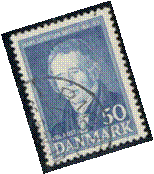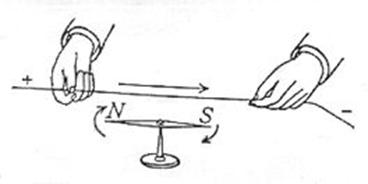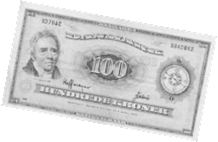Handout #20 - Hans Christian Oersted
Danish physicist
Born: Rudkobing, Langeland, August 14, 1777
Died: Copenhagen, March 9, 1851
 The young Hans worked in his father's apothecary shop, but this early training, which in most cases would have led straight to a career in chemistry, led to physics instead. He studied at the University of Copenhagen, traveled through Europe, and in 1806 was appointed professor of physics and chemistry at his alma mater.
The young Hans worked in his father's apothecary shop, but this early training, which in most cases would have led straight to a career in chemistry, led to physics instead. He studied at the University of Copenhagen, traveled through Europe, and in 1806 was appointed professor of physics and chemistry at his alma mater.

His brother Anders, younger by a year and a half, took to law, became attorney general of Denmark, and eventually the prime minister. He was a very unpopular prime minister and underwent impeachment proceedings after a forced resignation. It would seem, then, thanks to a single experiment, that Hans Oersted had taken the better road to fame.
It was in 1819 that Hans Oersted's great day came. He too was experimenting with the electric current, as half of Europe's scholars were doing. As part of a classroom demonstration, he brought a compass needle near a wire through which a current was passing. Scientists had long suspected there might be some connection between electricity and magnetism and Oersted may have felt that the current in the wire might have some effect on the needle.
 It did indeed. The compass needle twitched and pointed neither with the current nor against it, but in a direction at right angles to it. When he reversed the direction of the current, the compass needle veered and pointed in the opposite direction, but still at right angles.
It did indeed. The compass needle twitched and pointed neither with the current nor against it, but in a direction at right angles to it. When he reversed the direction of the current, the compass needle veered and pointed in the opposite direction, but still at right angles.
This was the first demonstration of a connection between electricity and magnetism so that Oersted's experiment may be considered the foundation of the new study of electromagnetism.
In 1820 Oersted's discovery was announced and it set off an explosion of activity. Arago and Ampere charged into the fray. Later, in the hands of Faraday and Henry especially, electromagnetism was to grow into an entity that was eventually to change the world as drastically as the steam engine had changed the world a century before and as the internal combustion engine was to change it half a century later.
 Poor Oersted could not keep up with the whirlwind of activity his experiment had stirred up. He was not clever with his hands but had always to work his experiments through assistants. He did show that the force of the current on the needle made itself felt through glass, metals, and other nonmagnetic substances, but except for that, did nothing further to follow up his own momentous discovery.
Poor Oersted could not keep up with the whirlwind of activity his experiment had stirred up. He was not clever with his hands but had always to work his experiments through assistants. He did show that the force of the current on the needle made itself felt through glass, metals, and other nonmagnetic substances, but except for that, did nothing further to follow up his own momentous discovery.